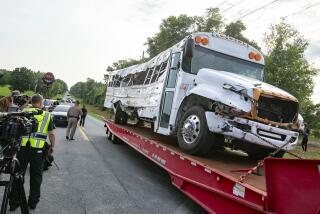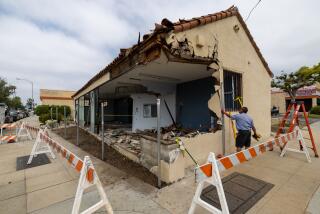A New Sense of Loss at Farmers Market
- Share via
Jury selection was beginning in the manslaughter trial of George Russell Weller last week when Shamsi Khani made her final trip to the Santa Monica Farmers’ Market, picking up the usual tomatoes along with plums and apricots to make her family’s favorite fruit rolls.
For years, the matriarch of an extended Iranian Jewish family had strolled on her own to the market from her ocean-view Santa Monica condo. But after Weller, then 86, plowed his car through the market in July 2003, killing 10 and injuring 63, an aide had to push her in a wheelchair.
Khani, 89 at the time of the tragedy, was Weller’s oldest victim.
The crash forever changed the two octogenarians’ lives.
Weller is now being tried in Los Angeles County Superior Court on 10 counts of felony manslaughter. Khani, meanwhile, spent the last three years recovering from grievous injuries and adjusting to new realities.
After being struck by Weller’s Buick LeSabre, Khani -- a popular market regular who knew many vendors by name -- was so badly mangled that doctors gave her little chance of surviving. Her right hip was broken, and her right tibia and fibula jutted out through her skin. Her left leg was fractured. Her right cheek was gashed, and her right ear had been cut in half. A temporal artery had been severed. Most troubling, her neck was broken.
She survived, but at the cost of her cherished independence. Because of her injuries, one leg was shorter than the other, causing her to sway when she used a walker. She could no longer stand in her kitchen to cook and bake. Yet, no matter how much pain she endured during her six months in hospitals and a convalescent home, and no matter how much she missed her old life, she could not bring herself to hate Weller, family members say.
“The only thing she talked about was that he was an old man and lost control and what can we do about it,” said Dan Khani, one of her sons. “She had compassion for him.”
Robert Ashley, one of Khani’s 24 grandchildren and a doctor who helped oversee her care in her final days, said she never expressed any bitterness about Weller.
Nor did she take satisfaction in the prospect that he would be punished.
“She would say there’s not a lot that you could do to this man at this point in his life,” Ashley said.
This week, Khani, 92, was absent from the Wednesday market. Her health had failed in recent days. She died early Friday at St. John’s Health Center in Santa Monica as family members clustered around her bed and sang “Shalom Aleichem,” the song of peace that begins the Shabbat meal on Friday nights.
When Khani entered the hospital with severe abdominal pain Tuesday, Dan Khani said, she had a premonition. She told family members: “Wednesday and Thursday nights I will be with you, but Friday I will be gone. But I expect you all to have your Friday evening together for Shabbat.”
“She just knew what was happening,” he said. On Friday night, the clan gathered in her honor at the Brentwood home of her daughter Jeanette Clavin.
Known to her family as “Maman,” an affectionate Persian term for matriarch, Khani grew up in Kermanshah, a provincial town in western Iran. At 14, she married Ely Khani, a young man with a promising future who went to her father and said, “I like your daughter.” They had seven children, six of whom survive. Ely Khani built a successful import-export business, trading in French products. He moved the family to Tehran for more opportunities and a more cosmopolitan atmosphere.
In the late 1940s, he decided that Iran’s religious intolerance made it impossible for him and his family to worship freely as Jews. Long before other Jews began to flee the country, he and Shamsi sent their eldest daughter to be educated at New York University. Eventually, the rest of the family followed to the United States.
Ely Khani died in 1999 at age 98. Interestingly, family members had taken away his car keys many years before when they realized that he could no longer drive safely.
She welcomed three new grandchildren in the last three years.
But her spirit flagged at times. She was one of dozens of victims who filed a civil suit against Santa Monica, which they said failed to protect them. “I pray to die,” she said in a deposition. A judge later dismissed the city from the case.
One of her greatest joys was shopping at the farmers market and preparing fresh tomato sauces and fruit-filled baked goods for her children and grandchildren. Indeed, as she lay battered in a hospital bed after the accident, Dan Khani would squeeze fresh basil between his fingertips and hold it up to her nose, reciting in Hebrew: “Thank you, God, for giving me the ability to smell the aroma of this product of your nature.”
In her final months, she would sit in a chair and cut fruits and vegetables on a small table. Odette Ashley-Freed, Robert Ashley’s sister, said she held her grandmother’s hand at the hospital and noticed small cuts and black marks on her thumb, evidence of her culinary efforts.
Vendors at the market greeted Khani’s return months after the tragedy with smiles and hugs. They showered her with summer squashes, lettuce and oranges, refusing to accept her money.
News of her death saddened one vendor. Reached on her cellphone, Vilma Causey of Briar Patch Farm in Kingsburg, Calif., began to weep.
“I saw her last week and I was already crying. I knew she was dying,” Causey said. “She was so thin.”
Last week, Khani made her usual purchase of Asian pears at Causey’s booth. “She was a really strong woman,” Causey said.
Even after the trauma of her injuries, “Maman” Khani recalled with remarkable clarity the circumstances of the crash. She was standing on Arizona Avenue, near 2nd Street, as Weller’s car neared the end of its 2 1/2 -block plunge through the market. “I was next to a tree, and it seemed like some part of a car or bicycle came like a snake and wrapped me around the tree,” she told The Times in September 2003. “It threw me up in the air.”
Gesturing with her large hands at the time, she told of landing on her head and neck and seeing her legs hanging in the air. When people rushed to help, she told them to worry about the younger victims.
As an ambulance rushed her to the UCLA Medical Center in Westwood, it passed Los Angeles National Cemetery. Convinced that she was dead, she told the paramedics: “This isn’t my cemetery. You have to take me to Sinai Temple.”
Her funeral will be at 10 a.m. Sunday at Mt. Sinai Memorial Park in Los Angeles.
More to Read
Sign up for Essential California
The most important California stories and recommendations in your inbox every morning.
You may occasionally receive promotional content from the Los Angeles Times.














